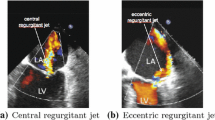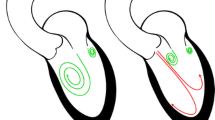Abstract
Grounded in hydrodynamic theory, proximal isovelocity surface area (PISA) is a simplistic and practical technique widely used to quantify valvular regurgitation flow. PISA provides a relatively reasonable, though slightly underestimated flow rate for circular orifices. However, for elliptical orifices frequently seen in functional mitral regurgitation, PISA underestimates the flow rate. Based on data obtained with computational fluid dynamics (CFD) and in vitro experiments using systematically varied orifice parameters, we hypothesized that flow rate underestimation for elliptical orifices by PISA is predictable and within a clinically acceptable range. We performed 45 CFD simulations with varying orifice areas 0.1, 0.3 and 0.5 cm2, orifice aspect ratios 1:1, 2:1, 3:1, 5:1, and 10:1, and peak velocities (Vmax) 400, 500 and 600 cm/s. The ratio of computed effective regurgitant orifice area to true effective area (EROAC/EROA) against the ratio of aliasing velocity to peak velocity (VA/Vmax) was analyzed for orifice shape impact. Validation was conducted with in vitro imaging in round and 3:1 elliptical orifices. Plotting EROAC/EROA against VA/Vmax revealed marginal flow underestimation with 2:1 and 3:1 elliptical axis ratios against a circular orifice (< 10% for 8% VA/Vmax), rising to ≤ 35% for 10:1 ratio. In vitro modeling confirmed CFD findings; there was a 8.3% elliptical EROA underestimation compared to the circular orifice estimate. PISA quantification for regurgitant flow through elliptical orifices produces predictable, but generally small, underestimation deemed clinically acceptable for most regurgitant orifices.








Similar content being viewed by others
References
Bargiggia GS, Tronconi L, Sahn DJ et al (1991) A new method for quantitation of mitral regurgitation based on color flow Doppler imaging of flow convergence proximal to regurgitant orifice. Circulation 84(4):1481–1489
Lancellotti P, Tribouilloy C, Hagendorff A et al (2013) Recommendations for the echocardiographic assessment of native valvular regurgitation: an executive summary from the European Association of Cardiovascular Imaging. Eur Heart J 14(7):611–644
Recusani F, Bargiggia GS, Yoganathan AP et al (1991) A new method for quantification of regurgitant flow rate using color Doppler flow imaging of the flow convergence region proximal to a discrete orifice. An in vitro study. Circulation 83(2):594–604
Zoghbi WA, Adams D, Bonow RO et al (2020) Recommendations for Noninvasive Evaluation of Native Valvular Regurgitation A Report from the American Society of Echocardiography Developed in Collaboration with the Society for Cardiovascular Magnetic Resonance. J Indian Acad Echocardiography Cardiovasc Imaging 4(1):58
Enriquez-Sarano M, Miller FA, Hayes SN et al (1995) Effective mitral regurgitant orifice area: clinical use and pitfalls of the proximal isovelocity surface area method. J Am Coll Cardiol 25(3):703–709
Rodriguez L, Anconina J, Flachskampf FA et al (1992) Impact of finite orifice size on proximal flow convergence. Implications for Doppler quantification of valvular regurgitation. Circul Res 70(5):923–930
Enriquez-Sarano M, Avierinos J-F, Messika-Zeitoun D et al (2005) Quantitative determinants of the outcome of asymptomatic mitral regurgitation. N Engl J Med 352(9):875–883
Grigioni F, Detaint D, Avierinos J-F et al (2005) Contribution of ischemic mitral regurgitation to congestive heart failure after myocardial infarction. J Am Coll Cardiol 45(2):260–267
Matsumura Y, Fukuda S, Tran H et al (2008) Geometry of the proximal isovelocity surface area in mitral regurgitation by 3-dimensional color Doppler echocardiography: difference between functional mitral regurgitation and prolapse regurgitation. Am Heart J 155(2):231–238
Song J-M, Kim M-J, Kim Y-J et al (2008) Three-dimensional characteristics of functional mitral regurgitation in patients with severe left ventricular dysfunction: a real-time three-dimensional colour Doppler echocardiography study. Heart 94(5):590–596
de Agustín JA, Marcos-Alberca P, Fernandez-Golfin C et al (2012) Direct measurement of proximal isovelocity surface area by single-beat three-dimensional color Doppler echocardiography in mitral regurgitation: a validation study. J Am Soc Echocardiogr 25(8):815–823
Iwakura K, Ito H, Kawano S et al (2006) Comparison of orifice area by transthoracic three-dimensional Doppler echocardiography versus proximal isovelocity surface area (PISA) method for assessment of mitral regurgitation. Am J Cardiol 97(11):1630–1637
Utsunomiya T, Ogawa T, Doshi R et al (1991) Doppler color flow “proximal isovelocity surface area” method for estimating volume flow rate: effects of orifice shape and machine factors. J Am Coll Cardiol 17(5):1103–1111
Nishimura RA, Otto CM, Bonow RO et al (2017) 2017 AHA/ACC focused update of the 2014 AHA/ACC guideline for the management of patients with valvular heart disease: a report of the American College of Cardiology/American Heart Association Task Force on Clinical Practice Guidelines. J Am Coll Cardiol 70(2):252–289
Hopmeyer J, He S, Thorvig KM et al (1998) Estimation of mitral regurgitation with a hemielliptic curve-fitting algorithm: in vitro experiments with native mitral valves. J Am Soc Echocardiogr 11(4):322–331
Hopmeyer J, Whitney E, Papp DA et al (1996) Computational simulations of mitral regurgitation quantification using the flow convergence method: comparison of hemispheric and hemielliptic formulae. Ann Biomed Eng 24(5):561–572
Kahlert P, Plicht B, Schenk IM et al (2008) Direct assessment of size and shape of noncircular vena contracta area in functional versus organic mitral regurgitation using real-time three-dimensional echocardiography. J Am Soc Echocardiogr 21(8):912–921
Marsan NA, Westenberg JJ, Ypenburg C et al (2009) Quantification of functional mitral regurgitation by real-time 3D echocardiography: comparison with 3D velocity-encoded cardiac magnetic resonance. JACC: Cardiovasc Imaging 2(11):1245–1252
Papolla C, Adda J, Rique A et al (2020) In vitro quantification of mitral regurgitation of complex geometry by the modified proximal isovelocity surface area method. J Am Soc Echocardiogr 33(7):838–847 e1
Utsunomiya T, Ogawa T, Tang HA et al (1991) Doppler color flow mapping of the proximal isovelocity surface area: a new method for measuring volume flow rate across a narrowed orifice. J Am Soc Echocardiogr 4(4):338–348
Jamil M, Ahmad O, Poh KK et al (2017) Feasibility of ultrasound-based computational fluid dynamics as a mitral valve regurgitation quantification technique: comparison with 2-D and 3-D proximal isovelocity surface area-based methods. Ultrasound Med Biol 43(7):1314–1330
Ashikhmina E, Shook D, Cobey F et al (2015) Three-dimensional versus two-dimensional echocardiographic assessment of functional mitral regurgitation proximal isovelocity surface area. Anesth Analgesia 120(3):534–542
Qin T, Caballero A, Hahn RT et al (2021) Computational analysis of virtual echocardiographic assessment of functional mitral regurgitation for validation of proximal isovelocity surface area methods. J Am Soc Echocardiogr 34(11):1211–1223
Domino SP (2015) Sierra Low Mach Module: Nalu Theory Manual 1.0, SAND2015-3107 W. Sandia National Laboratories Unclassified Unlimited Release (UUR)
Thomas J, Wilkins G, Choong C et al (1988) Inaccuracy of mitral pressure half-time immediately after percutaneous mitral valvotomy. Dependence on transmitral gradient and left atrial and ventricular compliance. Circulation 78(4):980–993
Thomas JD, Weyman AE (1987) Doppler mitral pressure half-time: a clinical tool in search of theoretical justification. J Am Coll Cardiol 10(4):923–929
Aurich M, André F, Keller M et al (2014) Assessment of left ventricular volumes with echocardiography and cardiac magnetic resonance imaging: real-life evaluation of standard versus new semiautomatic methods. J Am Soc Echocardiogr 27(10):1017–1024
Thavendiranathan P, Liu S, Datta S et al (2012) Automated quantification of mitral inflow and aortic outflow stroke volumes by three-dimensional real-time volume color-flow Doppler transthoracic echocardiography: comparison with pulsed-wave Doppler and cardiac magnetic resonance imaging. J Am Soc Echocardiogr 25(1):56–65
Pu M, Prior DL, Fan X et al (2001) Calculation of mitral regurgitant orifice area with use of a simplified proximal convergence method: initial clinical application. J Am Soc Echocardiogr 14(3):180–185
Rodriguez L, Thomas JD, Monterroso V et al (1993) Validation of the proximal flow convergence method. Calculation of orifice area in patients with mitral stenosis. Circulation 88(3):1157–1165
Pu M, Vandervoort PM, Greenberg NL et al (1996) Impact of wall constraint on velocity distribution in proximal flow convergence zone Implications for color Doppler quantification of mitral regurgitation. J Am Coll Cardiol 27(3):706–713
Pu M, Vandervoort PM, Griffin BP et al (1995) Quantification of mitral regurgitation by the proximal convergence method using transesophageal echocardiography: clinical validation of a geometric correction for proximal flow constraint. Circulation 92(8):2169–2177
Little SH, Igo SR, Pirat B et al (2007) In vitro validation of real-time three-dimensional color Doppler echocardiography for direct measurement of proximal isovelocity surface area in mitral regurgitation. Am J Cardiol 99(10):1440–1447
Matsumura Y, Saracino G, Sugioka K et al (2008) Determination of regurgitant orifice area with the use of a new three-dimensional flow convergence geometric assumption in functional mitral regurgitation. J Am Soc Echocardiogr 21(11):1251–1256
Schwammenthal E, Chen C, Giesler M et al (1996) New method for accurate calculation of regurgitant flow rate based on analysis of doppler color flow maps of the proximal flow field validation in a canine model of mitral regurgitation with initial application in patients. J Am Coll Cardiol 27(1):161–172
Francis DP, Willson K, Davies LC et al (2000) True shape and area of proximal isovelocity surface area (PISA) when flow convergence is hemispherical in valvular regurgitation. Int J Cardiol 73(3):237–242
Thomas JD (1997) How leaky is that mitral valve? Simplified Doppler methods to measure regurgitant orifice area. Circulation 95(3):548–550
Plicht B, Kahlert P, Goldwasser R et al (2008) Direct quantification of mitral regurgitant flow volume by real-time three-dimensional echocardiography using dealiasing of color Doppler flow at the vena contracta. J Am Soc Echocardiogr 21(12):1337–1346
Sitges M, Jones M, Shiota T et al (2003) Real-time three-dimensional color Doppler evaluation of the flow convergence zone for quantification of mitral regurgitation: validation experimental animal study and initial clinical experience. J Am Soc Echocardiogr 16(1):38–45
Thavendiranathan P, Liu S, Datta S et al (2013) Quantification of chronic functional mitral regurgitation by automated 3-dimensional peak and integrated proximal isovelocity surface area and stroke volume techniques using real-time 3-dimensional volume color Doppler echocardiography: in vitro and clinical validation. Circ Cardiovasc Imaging 6(1):125–133
Funding
Dr. James Thomas is supported by the Irene D. Pritzker Foundation and by grants from Abbott Vascular and GE Medical. Dr. Greg Wagner is supported by a grant from Abbott Vascular. Dr. Alex Barker is supported by NIH NHLBI Grants K25HL119608 & R01HL133504. Dr. Michael Markl is supported by NIH NHLBI Grants R01HL115828.
Author information
Authors and Affiliations
Corresponding author
Ethics declarations
Conflict of interest
Dr. Thomas reports consulting fees from Abbott Vascular, egnite, GE Medical, EchoIQ and Caption Health and spouse employment with Caption Health. Dr. Mitter reports honoraria from Alnylam and the National Minority Quality Forum.
Additional information
Publisher’s Note
Springer Nature remains neutral with regard to jurisdictional claims in published maps and institutional affiliations.
Electronic supplementary material
Below is the link to the electronic supplementary material.
Rights and permissions
Springer Nature or its licensor (e.g. a society or other partner) holds exclusive rights to this article under a publishing agreement with the author(s) or other rightsholder(s); author self-archiving of the accepted manuscript version of this article is solely governed by the terms of such publishing agreement and applicable law.
About this article
Cite this article
Lee, J., Mitter, S.S., Van Assche, L. et al. Impact of assuming a circular orifice on flow error through elliptical regurgitant orifices: computational fluid dynamics and in vitro analysis of proximal flow convergence. Int J Cardiovasc Imaging 39, 307–318 (2023). https://doi.org/10.1007/s10554-022-02729-2
Received:
Accepted:
Published:
Issue Date:
DOI: https://doi.org/10.1007/s10554-022-02729-2




